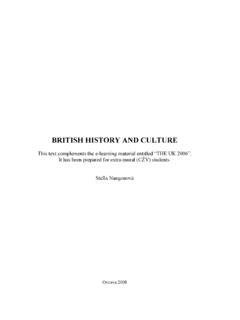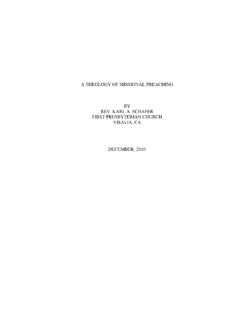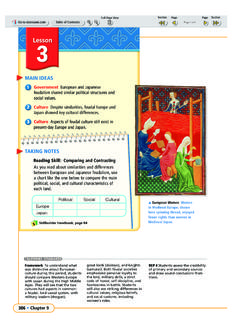Transcription of Roman Law in Scotland - Roman Law Resources
1 This is an electronic reprint from Roman Law Resources ( ). Copyright . 1995 The Stair Society. All rights reserved. This piece originally appeared as W. Gordon, ' Roman Law in Scotland ', in R. Evans-Jones, The Civil Law Tradition in Scotland [The Stair Society, supplementary series, vol. 2] (Edinburgh, 1995) (ISBN 1-872517-08-0), pp 13-40, and is reprinted here with the kind permission of the Stair Society. Authors should cite to the original work: the original pagination is noted below by use of angle brackets (< >).
2 All enquiries concerning the use or reproduction of this material should be addressed to the Stair Society. Roman Law in Scotland William M. Gordon, University of Glasgow I. Introduction II. The Period up to the Sixteenth Century III. Sixteenth and Seventeenth Centuries IV. The Eighteenth and Nineteenth Centuries V. The Present Day Addendum I. Introduction Scots law in the course of its history has had much closer contact with the European civilian tradition than has the English Common law but there have also been significant influences from the Common law.
3 This essay explores the civilian influence but in the course of doing so it must also look at the effect which contact with the Common law has had, especially since 1707. As backgound to discussion of Roman influence on Scots law some brief account of the demarcation of the boundaries of what was the kingdom and is now the 2 Gordon jurisdiction within which Scots law operates is The modern border between Scotland and England runs along a line from the river Solway on the west to the river Tweed on the east, excluding Berwick-upon-Tweed at the mouth of the Tweed which became an English possession finally in 1482.
4 Modern Scotland includes, besides the mainland, the Western Isles and the northern islands of Orkney and Shetland. However, Scotland became a single kingdom only in the early eleventh century and the somewhat artificial boundary between Scotland and England2 was drawn in the twelfth century, settling the disputed claims of the kings of Scotland to territory in northern England. Little is known with certainty of the laws applied among the various peoples who were brought under a single rule in the eleventh century the Picts, the Scots, the Britons and the Angles.
5 The same may be said of the Scandinavian settlements in the north and south-west but Scandinavian influence clearly predominated in the northern and western <14> islands which were brought within the Scottish kingdom at later dates the thirteenth century in the case of the Western Isles and the fifteenth century in the case of Orkney and It would be reasonable to assume a diversity of law, customary or other, among them and there is some firm evidence of that diversity, and indeed of some continuity of diverse custom and law, in references to special customs of Galloway in the south-west,4 to Celtic law in 1.
6 On the history of Scotland reference may be made to M. Lynch, Scotland : A New History, (2nd ed., London etc., 1992), the most modern single volume history, and for fuller treatments to the multi-volume Edinburgh History of Scotland , gen. ed. G. Donaldson. 4 vols. (Edinburgh, 1965-75) and The New History of Scotland , gen. ed. J. Wormald. 8 vols. (London, 1981-84, now being reissued by the Edinburgh University Press, with some volumes in revised editions). D. M. Walker offers a synthesis with particular emphasis on the law in A.
7 Legal History of Scotland , of which vols. 1 (The Beginnings to 1286), 2 (The Later Middle Ages), and 3 (The Sixteenth Century) (Edinburgh, 1988, 1990 and 1995) have appeared to date. [Editor's note see Addendum.]. 2. See the comment in H. Summerson, "The Early Development of the Laws of the Anglo- Scottish Marches, 1249-1449" in Legal History in the Making, edd. W. M. Gordon and T. D. Fergus (London and Rio Grande, 1991), 29-42 at 33. <14>. 3. The Western Isles were brought in by treaty with Norway in 1266.
8 Orkney and Shetland were pledged for the dowry of Margaret, daughter of Christian 1 of Denmark, who married James III of Scotland in 1468. They were forfeited to the Scottish crown in 1472 for non- payment of the dowry and redemption was never conceded. 4. See H. L. MacQueen, "The Laws of Galloway: a Preliminary Study" in Galloway: Land and Lordship, edd. R. D. Oram and G. P. Stell (Edinburgh, 1991), 131-43. 3 Gordon the Highlands and Western Isles5 and to Scandinavian law in Orkney and But the scanty early sources of Scots law assume in general a common law for Scotland .
9 They may give a misleading picture and the possibility that they do so must be kept in mind. Nevertheless the question what Roman influence there has been in Scots law has to be addressed in the light of what sources there are and these allow us to speak of "Scots law" even although there may be a suspicion that to do so imposes a uniformity which did not in fact exist and perhaps indeed reflects a later imposition of uniformity, of which imposition there is certainly vived from an some Although the Romans penetrated into Scotland and for a period occupied the southern part of modern Scotland between Hadrian's Wall, running from the Solway to the Tyne, and the Antonine Wall, running from the Clyde to the Forth, there is no clear evidence that that occupation continued into the third century.
10 It cannot, therefore, be stated with certainty that even southern Scotland was still part of the Roman empire when in 212 the Edict of Caracalla extended Roman citizenship to almost all inhabitants of the The Roman occupation of Scotland , such as it was, was limited and the Roman forces were withdrawn from the whole of Britain in the early fifth century. In these circumstances it seems unlikely that Roman occupation left any traces in the law even of southern Scotland . It has been stated confidently that <15> it did It is also very doubtful whether there was any influence, or any substantial influence, through contact with Rome by the peoples who came together to form the Scottish nation, even if in the present state of research it may be unwise to deny that possibility Influence through the Roman church would come into the reckoning.







